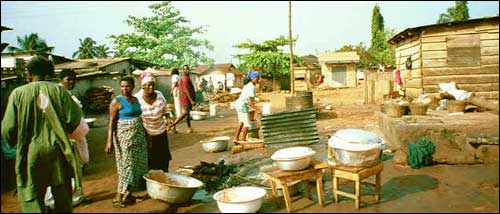For BASIC INFORMATION on situation,
click on title names below. |
For SUPPLEMENTARY INFORMATION,
click on blue balls under tab titles. |
| Key Issues and Challenges |
Customers & Providers |
Policies & Legal Aspects |
Funding & Cost Recovery |
Levels of Service |
 LOW-INCOME COMMUNITIES LOW-INCOME COMMUNITIES
Do low-income communities form a large part of the customer base and the majority of the unserved population? Will the bulk of future utility customers be low-income households? |
 |
|
|
|
 NATIONAL POLICY ON SERVICES NATIONAL POLICY ON SERVICES
Does national policy recognise the right of all people, including the urban poor, to access to a basic level of water and sanitation services? Are appropriate policies backed by supporting legislation and appropriate commitment? |
|
 |
|
|
 LOW-INCOME AS CUSTOMERS LOW-INCOME AS CUSTOMERS
Does the utility have a policy and strategy that treats all households, whether in planned or unplanned and/or informal settlements as legitimate customers? Are low-income households in unplanned and/or informal settlements traditionally accepted as “legitimate customers” by utilities? |
|
 |
|
|
 APPROPRIATE STANDARDS APPROPRIATE STANDARDS
Are the service and technical standards – often designed for formal/planned settlements - appropriate for informal settlements? |
|
|
|
 |
 ALTERNATIVE SERVICE PROVIDERS ALTERNATIVE SERVICE PROVIDERS
Does the utility recognize the proliferation of alternative service provider despite the extent of the services they offer? |
 |
|
|
|
 LOW-INCOME VOICE LOW-INCOME VOICE
Do the low-income have a ‘voice:’ do they have the right to a vote but not to a service? |
|
 |
|
|
 UNPLANNED SETTLEMENTS UNPLANNED SETTLEMENTS
Is the unplanned nature of low-incomesettlements physically difficult to provide services and at a higher cost? |
|
|
|
 |
 TARIFFS TARIFFS
Do the tariff structures disadvantage the poor,as well as the unconnected, second or third-hand customer? |
|
 |
 |
|
 REGULATORY STRUCTURES REGULATORY STRUCTURES
Are the regulatory structures and capacity to administer weak? Are the regulations inappropriate and outdated? |
|
 |
|
|
 INTEGRATION OF SERVICES INTEGRATION OF SERVICES
Are water, sewerage, sanitation and hygiene services adequately integrated? |
|
 |
|
 |
 PRIVATE SECTOR PARTICIPATION PRIVATE SECTOR PARTICIPATION
Is the private sector involved and what are the implications for the poor? |
 |
 |
|
|

